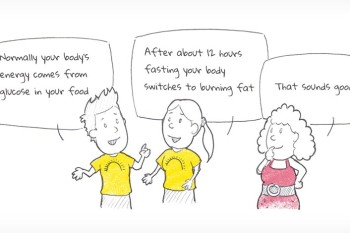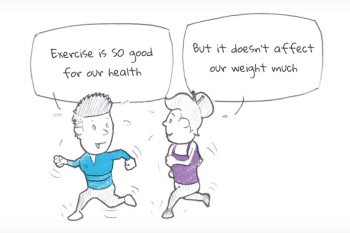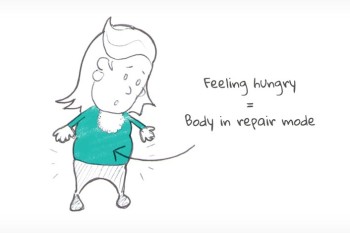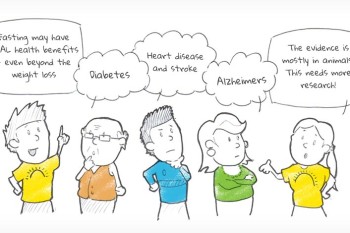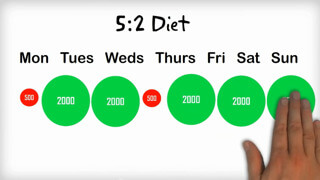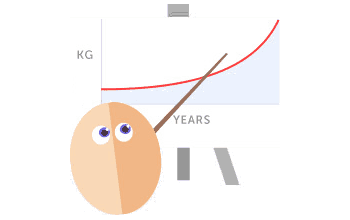Our bodies use hormones to control all the processes of metabolism. The most important hormones involved in controlling how glucose is used are insulin and glucagon.
Insulin is the key hormone acting after a meal. Its job is to ensure that most of the glucose we get from our food is stored away (as fat or glycogen) and does not remain in our blood for too long – this is why our bodies make insulin when our blood glucose levels rise. Controlling the amount of glucose in our blood is important for our health because glucose is toxic and damaging to the body. If insulin fails to keep blood glucose down to safe levels, damage occurs to many different tissues (our blood vessels, nerves, kidneys, eyes can all be damaged by high blood glucose) and we may eventually develop symptoms of diabetes. Because insulin’s job is to fill up the fat stores, when insulin levels are high we cannot release fat for energy. To allow fat to be released and used for energy we need other hormones to oppose the action of insulin.
Glucagon’s role is to stimulate the body to restore glucose levels if they are getting low and to ensure the body has a good energy supply. Glucagon stimulates the release of the stored glycogen, manufacture of glucose from fat and amino acids and release of fat from fat stores.
Learn more about fasting and diabetes
Diagram of insulin and glucagon in action

Is glucose or fat the best energy source for the body?
Fat is an excellent source of energy, and most of us have a large store of fat! For our normal activities (low intensity activity), fat can supply the energy we need and our muscles can be fuelled by fat burning. This is what normally happens when we are in the fasting state.
Our bodies will be fuelled by glucose instead of fat in one of two main situations:
-
When we need a short burst of intensive activity (running away from a marauding lion, for example) our muscles have to use glucose from the blood or from glycogen stored in our muscles. The chemical reactions for turning fat into energy are too slow in this situation. (Because our store of glycogen is fairly small, we can only operate at high intensities for short periods; this is why sprinters can only run at top speed for short distances.)
-
If you eat a normal Western diet that is high in carbohydrate, glucose is available pretty much all of the time and your body burns this glucose instead of fat. Many people’s bodies become dependent on a constant supply of glucose (from sugar or carbohydrate) in their diet, and the body becomes resistant to burning fat – a phenomenon called metabolic inflexibility.
Once someone becomes metabolically inflexible, it is difficult for them to lose weight. Their bodies are stuck in a situation where they are forever increasing their fat stores and never releasing the fat to be used for energy. This situation means they are often hungry despite having many thousands of calories-worth of fat stores because their bodies cannot access this store.1 Obese people tend to have metabolic inflexibility, particularly if the fat is carried in the abdomen.2
Adopting a new Way of Eating can free people from metabolic inflexibility – we recommend Intermittent fasting, but diets that incorporate a low-carb element, such as the Paleo diet can also be effective. Our bodies need a Way of Eating that re-educates them into using fat for energy, hence making weight loss easier.
Learn more about metabolism in weight loss
Learn more about how exercise affects metabolism
More detail for the scientifically inclined
Insulin works by stimulating muscle, adipose tissue, and the liver to remove glucose from the bloodstream:
-
In muscle, insulin stimulates glucose uptake from the bloodstream, the burning of glucose for energy, and conversion of glucose to glycogen
-
In adipose tissue, insulin stimulates glucose uptake from the bloodstream and the formation of stored fat
-
In liver, insulin prevents the formation of glucose from fats and amino acids and encourages conversion of glucose to glycogen and fat.
Glucagon acts in the liver to stimulate release of glucose from glycogen, creation of glucose from fats and amino acids, and production of ketones. Glucagon is secreted when blood glucose levels fall but can also be stimulated by nerves supplying the pancreas.
The balance of insulin and glucagon in the body is important in maintaining stable blood glucose levels. There is evidence that in type 2 diabetes, both insulin and glucagon secretion are raised.3
Several other important hormones are also involved in glucose metabolism. These include:
-
Adrenaline (epinephrine) is released when blood glucose levels fall and stimulates release of glucose in the liver and muscles and release of fat from adipose tissue. Sympathetic nerves supplying the adrenal glands can also stimulate adrenaline release.
-
Cortisol, a hormone produced in times of stress, is also an important hormone controlling glucose metabolism. Released when blood glucose levels fall, It stimulates manufacture of glucose from fatty acids and protein at the same time preventing glucose uptake so raising blood glucose levels.
-
Growth hormone (GH) has different effects depending on how long ago you ate. During fasting, GH stimulates the release of fatty acids and their use for fuel. It also prevents glucose from being taken up by muscles and adipose tissue, stimulates production of glucose from fatty acids but prevents glucose production from protein breakdown. GH is the main hormone controlling growth during childhood. After eating, however, GH promotes growth of new cells both directly, and by stimulating the release of a substance called insulin-like growth factor (IGF-1) from the liver and many other cells. IGF-1 acts to stimulate cell division (i.e., growth). Thyroid hormone is needed to enable GH to be synthesized.
These are just some of the hormones involved in metabolism. In fact, it is much more complicated than this! There are many good sources of further information on the internet, for example boundless.com.
Diagram for the super nerdy

Source: Nature Medicine
Click to view large format PDF version


